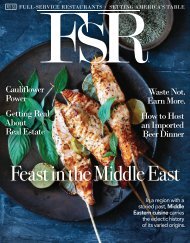FSR magazine April 2018
You also want an ePaper? Increase the reach of your titles
YUMPU automatically turns print PDFs into web optimized ePapers that Google loves.
Wealthy families might slaughter a goat<br />
once a month, but the majority of people<br />
eat primarily vegetarian—vegetable<br />
stews and a variety of hot and cold<br />
mezze.<br />
Massoud opened fine-dining ilili in<br />
Manhattan’s Flatiron district in 2008<br />
as an answer to the success of high-end<br />
Japanese spots Nobu and Zuma. “What<br />
they did to Asian cuisine, we hope to<br />
achieve with Levantine cuisine,” he says.<br />
Ilili’s herbaceous, lightly dressed tabbouleh<br />
reflects the region’s abundance,<br />
while the hummus is almost theological<br />
in its ratios: “Just soft enough to<br />
maintain the integrity of the chickpea,<br />
just nutty enough to give the flavor of<br />
tahini, and just lemony enough for a hint<br />
of acidity when you drizzle it with olive<br />
oil and scoop it up with pita,” Massoud<br />
says. “It took a while for people to appreciate<br />
what we consider the real deal.”<br />
What’s pervasive across the menu is<br />
a purposeful lightness to entice people<br />
to come back, which Massoud achieved<br />
through reducing the fat, oil, and salt.<br />
“I wanted people to come and have an<br />
orgy of food and still be able to go dancing,”<br />
he says.<br />
Tasting Tehrangeles<br />
About half of the country’s Iranian population<br />
lives in Los Angeles, according to<br />
U.S. Census data. The region’s diaspora<br />
has been lovingly dubbed Tehrangeles.<br />
Yet for a long time, residents’ exposure<br />
to the cuisine was largely via sandwich<br />
shops and kebab houses, like shoeboxsized<br />
Attari and beloved strip-mall storefront<br />
It’s All Good House of Kabob.<br />
“These days, more people are realizing<br />
that Persian food is simple, healthy, and<br />
delicious,” says Shawn Saloot, partner of<br />
stalwart Darya Restaurant in Orange<br />
County and West Los Angeles. “I think<br />
that is why it is becoming popular.”<br />
Iran is home to one of the world’s oldest<br />
continuous major civilizations, with<br />
historical and urban settlements dating<br />
back to 7,000 B.C. Once a major empire,<br />
the country has endured invasions by<br />
the Greeks, Arabs, Turks, and Mongols—<br />
though it’s reasserted its national identity<br />
throughout the centuries. Historical<br />
interactions with neighboring regions<br />
have undoubtedly affected the cuisine,<br />
though, with Caucasian, Levantine,<br />
Greek, Central Asian, Russian, and Turkish<br />
gastronomy all leaving their mark.<br />
“Persian food originated from different<br />
parts of Iran, each with their own<br />
specific and unique culture and geography,<br />
such as the Caspian Sea whitefish<br />
with herb rice,” Saloot says. “But<br />
let me tell you something, Persian food<br />
is not spicy at all.” Rather, he says, it’s<br />
more often tinged with aromatic saffron,<br />
turmeric, and cinnamon. Grilled meat<br />
is often the centerpiece, with rice and<br />
bread being staples of every Persian table.<br />
Saloot opened Darya with his brother<br />
Ali Saloot in 1985, opting for old-school<br />
elegance via chandeliers, Victorian décor,<br />
and an ambitious menu of traditional<br />
Persian meats, stews, and rice dishes.<br />
They opened a second outpost in Santa<br />
Monica 10 years later.<br />
The Saloots draw from Southern<br />
California’s agricultural abundance to<br />
faithfully re-create classic dishes, such<br />
as kashke bademjan, with sauteed eggplant<br />
mixed with yogurt, fried garlic,<br />
turmeric, fried onion, and topped with<br />
sautéed mint, garlic, and kashk (whey<br />
sauce). Their famous tahdig, or crispy<br />
rice from the bottom of the pot, is<br />
heaped with Fesenjan stew, made from<br />
slow-boiled chicken in a sauce of evenslower-cooked<br />
pomegranate and ground<br />
walnuts. Homespun touches permeate<br />
Juicy Chicken—a kebab made from<br />
chicken-breast medallions marinated<br />
overnight in lemon juice, saffron, corn<br />
oil, salt, and pepper, then charbroiled—<br />
which was so named by Saloot’s then-7-<br />
year-old son.<br />
Yet even as the landscape has grown<br />
more crowded with spots like stylish<br />
Flame and Iranian-American Cafe<br />
Glacé doling out lamb tahchin—saffron<br />
rice cakes—and Persian gyros, Darya<br />
remains true to the Saloot’s Iran for 33<br />
years and counting.<br />
“I cannot change the traditional Iranian<br />
food,” Saloot says. “We have only<br />
tried to keep its standard the highest<br />
possible by using fresh and quality ingredients.”<br />
Your Sales Are<br />
always the main<br />
ingredient<br />
Pasta e Fagioli<br />
No one has a more<br />
complete or effective<br />
program for success in<br />
prepared premium-quality<br />
food sales than Blount.<br />
Blount quality makes the<br />
difference – and builds<br />
your business.<br />
To learn more about our<br />
premium soups, contact<br />
Blount at 800-274-2526.<br />
PROFIT FROM<br />
OUR EXPERIENCE<br />
WWW.BLOUNTFINEFOODS.COM<br />
VISIT US AT THE NRA<br />
MAY 20-22<br />
BOOTH # 1831<br />
TM<br />
FOODNEWSFEED.cOm <strong>April</strong> <strong>2018</strong> 53



